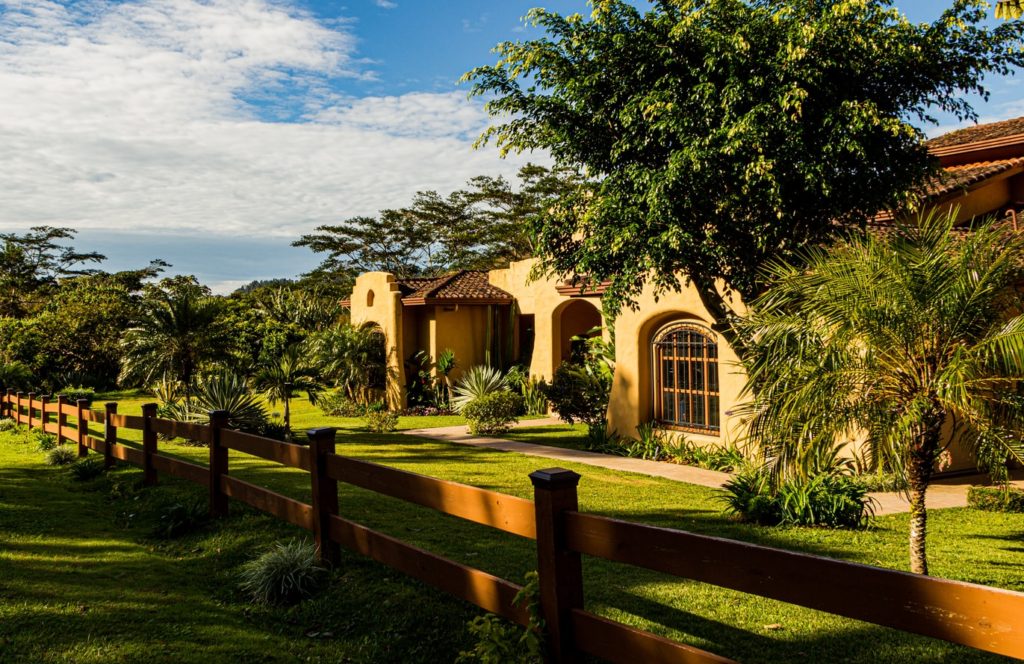Real estate photographers bring their professional eye for visuals to create images that show off a property in its most appealing light. Clients can be real estate agents and private individuals selling their own homes or commercial property.

Your images are displayed on websites and in printed brochures as selling tools. As a result, clients expect crisp, sharply focused images that are lighted properly and highlight the property details the seller most wants to promote, whether it’s a newly remodeled kitchen or a stunningly landscaped backyard.
This means real estate photographers must be comfortable shooting indoors under artificial light conditions just as they can capture great photos outdoors, whether the sun is shining or it’s a cloudy day.
In addition to the artistic creativity that comes with real estate photography, you can be your own boss and to a large degree set your own schedule. While beginners might have to wait outside a house for the realtor to show up and let them inside to start photographing, once you’ve developed a reputation for professionalism and reliability, many realtors may decide to give you access to the lockbox outside a home for sale. Then you’ll be able to let yourself in, do your work and lock up again when finished.
Another benefit to work as a real estate photographer is you probably won’t need to invest in as much equipment as, say, a wedding or portrait photographer whose work requires elaborate lighting setups.
Read on to learn how you can get started in the lucrative and rewarding career of real estate photography.
In this article you’ll learn:
- How much money you can make as a real estate photographer
- The required training and certifications
- Professional groups to join
- Employment opportunities for real estate photographers
- Finding clients
- Plus helpful tips
How much money can you make?
Real estate photographers on average make $60,520 a year according to a recent ZipRecruiter survey of professionals in the field. Location and clientele play a role in how much you can make, just as drive and ambition determine how much work you can take on. Learn how to shoot 3D videos and you can double your income. A 3D video lets prospective homebuyers take a virtual tour of a property before committing to an actual walk-through with a realtor. Real estate agents love 3D videos because it saves them a huge amount of time. Only people seriously interested will make an appointment for a walk-through of a house. The videos help weed out the casual shoppers from the committed buyers.
Training and Certification
Realtors need a license to offer their services, but you don’t. Photography is not licensed or regulated at the state level in the United States. There is a slight chance some regulations are in place at the city or county level. A quick call to your local government will confirm one way or another if there are any regulations governing photographers in your area. Chances are, there will be none.

It can still be extremely helpful to train specifically for work in real estate photography. This can save you a lot of time by learning common mistakes to avoid that you might otherwise endure through trial and error on the job. The difference is knowing mistakes to avoid in advance means you deliver images to the client faster and offer better customer service. Few realtors are likely to be happy if they have to make a second trip to a house you were supposed to photograph, only you forgot to bring a spare memory card and couldn’t take any more pictures.

Many training programs are available online to help you learn the basics of real estate photography. Most are highly affordable. Here’s one example.
What you’ll learn in a basic training course:
- Indoor and outdoor architectural photography techniques
- Use of a digital camera, lenses, tripods, shutter release systems or wireless camera triggers.
- Choosing and carrying the right gear for the job
- Intermediate Photoshop skills for editing images.
- Effective use of a camera flash, strobe or other lighting equipment.
- Basic business and marketing skills useful to a professional photographer, including tax withholding and setting up a small business legally.
With advanced courses you can learn how to shoot and edit high-definition video of property for sale. This gives you an extra service to sell to your clients.
Most online training programs give you lifetime access to the materials once you’ve paid for the course. You’ll also probably be able to download and print a customized certificate of completion that you can frame and hang in your office as well as highlight on your marketing materials. Certifications go a long way toward inspiring client confidence.
Professional Groups to Join
The Association of Real Estate Photographers is an advocacy organization for the industry. Membership costs $185 per year and comes with these benefits:
- Certification with the Association
- Use of AREP Logo on your website and print collateral
- Association-approved License for use with Agents/Brokers – downloadable
- Access to Legal Counsel
- Discounts on the National Conference
- Assistance with licensing disputes
- Relationship with your MLS. Work through the association for any issues with Agent/Broker/MLS image use
- Member listing in Association directory and individual member page for marketing

The Real Estate Photographers of America & International is an Internet-based trade association that advocates for the industry and promotes the professional success of certified real estate photographers. Membership is $125 per year and includes up to 3 directory listings for you and your business. This helps new clients find you. The organization has specific requirements for photographers’ websites as well as adherence to a code of ethics, which can be reviewed on the application form here.
Professional Photographers of America is the premiere organization of photography pros in the United States. A full membership is open to anyone living in the United States or its territories and costs $323 per year. Benefits include:
- $15,000 equipment insurance policy
- Data loss protection
- Access to all online education course
- Online referral database listing
- Printed and digital monthly issues of Professional Photographer magazine
- One full registration to Imaging USA during the first year of membership
- Business Resources
- Contracts and Copyright Resources
- Access to Member Discount Program
- Weekly newsletter
Employment
Visit local realtor offices to drop off your marketing materials, brochures and business cards. Follow up with a phone call in a day or two. If a realtor says she’s already working with a photographer, ask if she knows any realtors who need your services. Don’t be discouraged by rejection when calling realtors. The very next call you make could be gold.

Use the networking power of your professional memberships to find jobs.
Attend local gatherings of real estate agents (they get together a lot to talk shop) so you can introduce yourself and distribute business cards.
Finding Clients
Business cards and a basic website should be the core of your marketing toolkit. The website need not be fancy or expensive. Just attractively designed, with photos of your best work, location and contact information. No need to include your pricing unless you know that your fees are less than what competitors are asking. Posting prices is a slippery slope. Before you know it, you’re updating your website every other day to keep pace with the competition. It can turn out to be a fast race to the bottom.
In addition to your business website, create an Instagram account to showcase your photography services. Instagram is the #1 online venue for creative professionals to display their work.
Other strategies for attracting new business:
- Create a referral program with discounts for returning customers who bring new clients to you.
- Ask clients to review your services online. According to a recent survey, 90% of people say their buying decisions are influenced by positive online reviews.
Good to know
Here are tips and tricks used by professional real estate photographers to get great results and save time on the job.

- Examine the house before you start shooting the first image. Walk through the house, around the yard, and get a sense of the compositions you want to capture that will show off the property to maximum advantage. Plan on taking 2-3 photos of every room, as well as outdoor coverage on all sides of the house.
- Open the blinds and curtains. Natural light looks best. You can always supplement the available light with a flash.
- Be selective in turning on indoor lights. For example, you can create an inviting, even romantic mood for the dining room by dimming the lights.
- Make sure your prices are in line with the competition in your area. Not getting any calls? Maybe you’re charging too much. Or not enough. Realtors may be wary of rock-bottom prices.

- Use a tripod and remote shutter as much as possible, but especially in low light. Clear, stable images free of blur are your most valuable commodity.
- Buy and use wide-angle lenses. These will give you maximum coverage of large rooms and landscaping that you cannot achieve with a fixed lens.
- Use polarizing filters outdoors. These filters come in different strengths to block a certain amount of light – like additional f-stops for your camera. On bright, sunny days a polarizing filter can prevent your images from looking washed out.
- Carry spare batteries and memory cards. Better to have extra power and memory and not need it, than to run out of either and have no spares.
- Keep a two-step ladder in the trunk of your car. You can haul it out and use the ladder to gain a different perspective that can add depth and height to your compositions.
- Look for unusual angles that add greater visual interest.
- Use a wide-angle (24mm) lens for rooms and outdoor shots. Switch to a standard 50mm lens to capture details and features.
- Set your camera properly. As a rule of thumb, you’ll get best results with an aperture from f/7.1 to f/9 combined with a shutter speed between 1/60 and 1/2 a second, depending on your lighting conditions. Use as low an ISO setting as possible to prevent image “noise.”
- Learn the basics of Photoshop. The best photographers edit their images as part of post-production. Photoshop is not inexpensive and it has a steep learning curve to use with expertise, but it is the industry standard for editing digital photography. As an alternative, you can download and use the image editing program GIMP for free. GIMP is a powerful image editing solution with a user-friendly interface. It is compatible with Windows, Mac and Linux operating systems.
- For the best images shoot in the RAW format. This format provides the highest resolution your camera can capture and is particularly useful in editing digital photos. All the top pros shoot in the RAW format. On the downside, RAW images devour a lot of memory. Unless your clients are finicky and demand magazine-quality images, you may be able to get by shooting in the JPEG format, which requires significantly less storage space on your camera’s memory card.
If you enjoyed this article, check out some more great PocketSuite.io content that can help you grow your career as a real estate photographer. Here’s a great place to start.PocketSuite has thousands of business owners who all started where you are right now. Our community is always happy to help you ramp up, grow your client base, and achieve your income goals, both within the PocketSuite app and as part of our exclusive Facebook Community Group. PocketSuite’s vision is for any professional to be able to work for themselves and make a great living. It starts here. It starts with you. It starts today. Let’s get started, download PocketSuite now! Feel free to reach out with any questions (we’d love to hear from you)! Text us @ (415) 841-2300.





